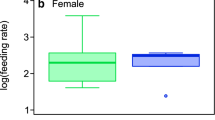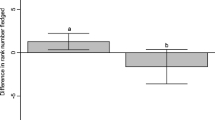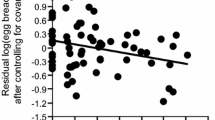Abstract
The length of the ornamental tail rectrices has been shown to be an important condition-dependent sexually selected trait in various bird species. Similarly, the shape and depth of the tail fork may represent a costly sexual signal that enhances individual attractiveness but compromises flight manoeuvrability. Avian flight feathers, including ornamental rectrices, generally become longer in successive years. In this study, we analysed age and sex differences in the length of central tail feathers and the depth of the tail fork in 141 Barn Swallows observed repeatedly over consecutive years. As expected, tail fork depth was mainly determined by the length of the outer ornamental tail streamers and to some extent to the non-ornamental central feathers, with individuals with deeper forks having longer outer streamers and shorter central tail feathers. Central tail feathers were sexually dimorphic and shorter in males than females. We also found an unexpected pattern of shortening of central tail feathers with increasing age that contributed to an age-related increase in tail fork depth in both sexes. The shortening of central tail feathers was achieved by the reduction of daily feather growth rates and not by feather abrasion. To the best of our knowledge, our study provides the first evidence of age-related continuous shortening of flight feathers in an avian species and suggests a possible sexual role of central tail feather length in Barn Swallows.
Zusammenfassung
Ein unerwartetes altersbedingtes Muster im Federwachstum trägt zur altersabhängigen Ornamentexpression eines Singvogels bei. Es ist bekannt, dass die Länge ornamentaler Steuerfedern bei verschiedenen Vogelarten ein wichtiges konditionsabhängiges und der sexuellen Selektion unterworfenes Merkmal darstellt. Auf ähnliche Weise können Form und Tiefe der Schwanzgabelung ein kostspieliges sexuelles Signal darstellen, welches zwar die individuelle Attraktivität erhöht, aber die Manövrierfähigkeit beim Flug behindert. Bei Vögeln werden die Federn des Großgefieders, darunter auch ornamentale Steuerfedern, in der Regel mit den Jahren länger. In dieser Studie analysierten wir Alters- und Geschlechtsunterschiede bezüglich der Länge der mittleren Steuerfedern sowie der Tiefe der Schwanzgabelung bei 141 Rauchschwalben Hirundo rustica, welche über eine Reihe von Jahren hinweg wiederholt beobachtet wurden. Erwartungsgemäß wurde die Tiefe der Schwanzgabelung hauptsächlich durch die Länge der ornamental verlängerten äußeren Steuerfedern sowie in gewissem Maße durch die nicht-ornamentalen mittleren Federn bestimmt, wobei Individuen mit tieferer Gabelung längere äußere Schmuckfedern und kürzere mittlere Steuerfedern hatten. Die mittleren Steuerfedern wiesen einen Geschlechtsdimorphismus auf und waren bei den Männchen kürzer als bei den Weibchen. Außerdem entdeckten wir ein unerwartetes Muster verkürzter mittlerer Steuerfedern mit zunehmendem Alter, welches bei beiden Geschlechtern zu der altersabhängigen Vertiefung der Schwanzgabelung beiträgt. Die Verkürzung der mittleren Steuerfedern wurde durch die Reduktion der täglichen Federwachstumsrate bewirkt, nicht durch Gefiederabnutzung. Soweit wir wissen, liefert unsere Studie die ersten Belege für eine altersabhängige fortlaufende Verkürzung von Federn des Großgefieders bei einer Vogelart und weist auf eine mögliche geschlechtsspezifische Rolle der Länge der mittleren Steuerfedern bei Rauchschwalben hin.



Similar content being viewed by others
Data accessibility
The data supporting the results will be archived in the Dryad repository.
References
Adámková M, Bílková Z, Tomášek O, Šimek Z, Albrecht T (2019) Feather steroid hormone concentrations in relation to age, sex, and molting time in a long-distance migratory passerine. Ecol Evol 9:9018–9026. https://doi.org/10.1002/ece3.5447
Alatalo R, Höglund J, Lundberg A (1988) Patterns of variation in tail ornament size in birds. Biol J Linn Soc 34:363–374. https://doi.org/10.1111/j.1095-8312.1988.tb01969.x
Balbontín J, Møller AP, Hermosell IG, Marzal A, Reviriego M, de Lope F (2009) Geographic patterns of natal dispersal in barn swallows Hirundo rustica from Denmark and Spain. Behav Ecol Sociobiol 63:1197–1205. https://doi.org/10.1007/s00265-009-0752-3
Balbontín J, de Lope F, Hermosell IG, Mousseau TA, Møller AP (2011) Determinants of age-dependent change in a secondary sexual character. J Evol Biol 24:440–448. https://doi.org/10.1111/j.1420-9101.2010.02183.x
Balmford A, Thomas ALR, Jones IL (1993) Aerodynamics and the evolution of long tails in birds. Nature 361:628–631. https://doi.org/10.1038/361628a0
Barbosa A, Møller AP (1999) Sexual selection and tail streamers in the barn swallow: appropriate tests of the function of size-dimorphic long tails. Behav Ecol 10:112–114. https://doi.org/10.1093/beheco/10.1.112
Barbosa A, Merino S, Cuervo JJ, de Lope F, Møller AP (2003) Feather damage of long tails in barn swallows Hirundo rustica. Ardea 91:85–90
Bates D, Mächler M, Bolker B, Walker S (2015) Fitting linear mixed-effects models using lme4. J Stat Softw 67:1–48. https://doi.org/10.18637/jss.v067.i01
Brewer M, Butler A, Cooksley S (2016) The relative performance of AIC, AICC and BIC in the presence of unobserved heterogeneity. Methods in Ecol Evol 7:679–692. https://doi.org/10.1111/2041-210X.12541
Bro-Jørgensen J, Johnstone R, Evans M (2007) Uninformative exaggeration of male sexual ornaments in Barn Swallows. Curr Biol 17:850–855. https://doi.org/10.1016/j.cub.2007.03.042
Costanzo A, Ambrosini R, Caprioli M, Gatti E, Parolini M, Canova L, Rubolini D, Romano A, Gianfranceschi L, Saino N (2017) Lifetime reproductive success, selection on lifespan, and multiple sexual ornaments in male European barn swallows. Evolution 71:2457–2468. https://doi.org/10.1111/evo.13312
Crawley M (2013) The R Book. Wiley, Chichester
Cuervo J, Møller AP (2009) The allometric pattern of sexually size dimorphic feather ornaments and factors affecting allometry. J Evol Biol 22:1503–1515. https://doi.org/10.1111/j.1420-9101.2009.01758.x
Evans M (1998) Selection on swallow tail streamers. Nature 394:233–234. https://doi.org/10.1093/beheco/10.1.112
Evans S, Gustafsson L, Sheldon B (2011) Divergent patterns of age-dependence in ornamental and reproductive traits in the collared flycatcher. Evolution 65:1623–1636. https://doi.org/10.1111/j.1558-5646.2011.01253.x
Flinks H, Salewski V (2012) Quantifying the effect of feather abrasion on wing and tail lengths measurements. J Ornithol 153:1053–1065. https://doi.org/10.1007/s10336-012-0834-2
Hasegawa M, Arai E (2013) Divergent tail and throat ornamentation in the barn swallow across the Japanese islands. J Ethol 31:79–83. https://doi.org/10.1007/s10164-012-0352-y
Hasegawa M, Arai E (2020) Fork tails evolved differently in swallows and swifts. J Evol Biol 33:911–919. https://doi.org/10.1111/jeb.13622
Hasegawa M, Arai E, Kutsukake N (2016) Evolution of tail fork depth in genus Hirundo. Ecol Evol 6:851–858. https://doi.org/10.1002/ece3.1949
Horák K, Bobek L, Adámková M, Kauzálová T, Pouadjeu J, Nguelefack T, Nana E, Jonsson K, Munclinger P, Hořák D, Sedláček O, Tomášek O, Albrecht T (2022) Feather growth and quality across passerines is explained by breeding rather than moulting latitude. Proc R Soc B. https://doi.org/10.1098/rspb.2021.2404 ((in Press))
Jenni L, Winkler R (2020) Adjustments to the plumage. The biology of moult in birds. Helm, UK, pp 43–56
Kauzálová T, Tomášek O, Mulder E, Verhulst S, Albrecht T (2022) Telomere length is highly repeatable and declines with more elaborate sexual ornamentation in a short-lived passerine. Mol Ecol. https://doi.org/10.22541/au.162168373.30898458/v1
Kleven O, Jacobsen F, Izadnegahdar R, Robertson R, Lifjeld J (2006) Male tail streamer length predicts fertilization success in the North American barn swallow (Hirundo rustica erythrogaster). Behav Ecol Sociobiol 59:412–418. https://doi.org/10.1007/s00265-005-0065-0
Laucht S, Dale J (2012) Correlations of condition, testosterone, and age with multiple ornaments in male house sparrows: patterns and implications. Condor 114:865–873. https://doi.org/10.1525/cond.2012.110194
Lifjeld J, Kleven O, Jacobsen F, McGraw K, Safran R, Robertson R (2011) Age before beauty? Relationships between fertilization success and age-dependent ornaments in barn swallows. Behav Ecol Sociobiol 65:1687–1697. https://doi.org/10.1007/s00265-011-1176-4
Michálková R, Tomášek O, Adámková M, Kreisinger J, Albrecht T (2019) Extra-pair paternity patterns in European barn swallows Hirundo rustica are best explained by male and female age rather than male ornamentation. Behav Ecol Sociobiol 73:119. https://doi.org/10.1007/s00265-019-2725-5
Møller AP (1988) Female choice selects for male sexual tail ornaments in the monogamous swallow. Nature 332:640–642. https://doi.org/10.1038/332640a0
Møller AP (1991) Sexual selection in the monogamous barn swallow (Hirundo rustica). I. Determinants of tail ornament size. Evolution 45:1823. https://doi.org/10.2307/2409834
Møller AP (1994) Sexual selection and the barn swallow. Oxford University Press, Oxford
Møller AP (1995) Sexual selection in the barn swallow (Hirundo rustica). V. Geographic variation in ornament size. J Evol Biol 8:3–19. https://doi.org/10.1046/j.1420-9101.1995.8010003.x
Møller AP, de Lope F (1994) Differential costs of a secondary sexual character: an experimental test of the handicap principle. Evolution 48:1676–1683. https://doi.org/10.1111/j.1558-5646.1994.tb02204.x
Møller AP, de Lope F (1999) Senescence in a short-lived migratory bird: age-dependent morphology, migration, reproduction and parasitism. J Anim Ecol 68:163–171. https://doi.org/10.1046/j.1365-2656.1999.00274.x
Møller AP, Szép T (2002) Survival rate of adult Barn Swallows Hirundo rustica in relation to sexual selection and reproduction. Ecology 83:2220–2228
Møller AP, Szép T (2005) Rapid evolutionary change in a secondary sexual character linked to climatic change. J Evol Biol 18:481–495. https://doi.org/10.1111/j.1420-9101.2004.00807.x
Møller AP, de Lope F, Saino N (1995) Sexual selection in the barn swallow Hirundo rustica. VI. Aerodynamic adaptations. J Evol Biol 8:671–687. https://doi.org/10.1046/j.1420-9101.1995.8060671.x
Møller AP, Barbosa A, Cuervo J, Lope F, Merino S, Saino N (1998) Sexual selection and tail streamers in the barn swallow. Proc R Soc B 265:409–414. https://doi.org/10.1098/rspb.1998.0309
Norberg RA (1994) Swallow tail streamer is a mechanical device for self-deflection of tail leading edge, enhancing aerodynamic efficiency and flight manoeuvrability. Proc R Soc B 257:227–233. https://doi.org/10.1098/rspb.1994.0119
Palestis B, Nisbet I, Hatch J, Arnold J, Szczys P (2012) Tail length and sexual selection in a monogamous, monomorphic species, the Roseate Tern Sterna dougallii. J Ornithol 153:1153–1163. https://doi.org/10.1007/s10336-012-0846-y
Pap P, Fülöp A, Adamkova M, Cepak J, Michalkova R, Safran R, Stermin A, Tomasek O, Vágási C, Vincze O, Wilkins M, Albrecht T (2019) Selection on multiple sexual signals in two Central and Eastern European populations of the barn swallow. Ecol Evol 9:11277–11287. https://doi.org/10.1002/ece3.5629
Pérez-Tris J, Telleria J (2001) Age-related variation in wing shape of migratory and sedentary Blackcaps Sylvia atricapilla. J Avian Biol 32:207–213. https://doi.org/10.1111/j.0908-8857.2001.320301.x
Piliczewski P, Jankowiak Ł, Wysocki D (2018) Age-dependent changes in biometrics indicate senescence in the European Blackbird Turdus merula. Bird Study 65:219–224. https://doi.org/10.1080/00063657.2018.1451821
R Core Team (2019) R: a language and environment for statistical computing. R Foundation for Statistical Computing, Vienna, Austria. https://www.R-project.org/
Rowe L, Evans M, Buchanan K (2001) The function and evolution of the tail streamer in Hirundines. Behav Ecol 12:157–163. https://doi.org/10.1093/beheco/12.2.157
Safran RJ (2010) Barn swallows: sexual and social behaviour. In: Breed MD, Moore J (eds) Encyclopedia of animal behaviour, vol 1. Academic Press, Oxford, pp 139–144
Saino N, Bolzern A, Møller AP (1997) Immunocompetence, ornamentation, and viability of male barn swallows (Hirundo rustica). Proc Natl Acad Sci USA 94:549–552. https://doi.org/10.1073/pnas.94.2.549
Saino N, Romano M, Caprioli M, Ambrosini R, Rubolini D, Scandolara C, Romano A (2012) A ptilochronological study of carry-over effects of conditions during wintering on breeding performance in the barn swallow Hirundo rustica. J Avian Biol 43:513–524. https://doi.org/10.1111/j.1600-048X.2012.05622.x
Sieffermann L, Hill GE, Dobson FE (2005) Ornamental plumage coloration and condition are dependent on age in eastern bluebirds Sialia sialis. J Avian Biol 36:428–435. https://doi.org/10.1111/j.0908-8857.2005.03401.x
Svensson L (2006) Identification guide to European passerines. Stockholm
Szép T, Dobránszky J, Møller AP, Dyke G, Lendvai Á (2019) Older birds have better feathers: a longitudinal study on the long-distance migratory Sand Martin, Riparia riparia. PLoS One 14:e0209737. https://doi.org/10.1371/journal.pone.0209737
Thomas A (1993) On the aerodynamics of birds’ tails. Philos Trans R Soc Lond B Biol Sci 340:361–380. https://doi.org/10.1098/rstb.1993.0079
Van de Pol M, Verhulst S (2006) Age-dependent traits: a new statistical model to separate within- and between-individual effects. Am Nat 167:766–773. https://doi.org/10.1086/503331
Vitousek M, Tomášek O, Albrecht T, Wilkins M, Safran R (2016) Signal traits and oxidative stress: a comparative study across populations with divergent signals. Front Ecol Evol. https://doi.org/10.3389/fevo.2016.00056
Wickham H (2016) ggplot2: elegant graphics for data analysis. Springer, New York
Zusi R, Gill F (2009) The Marvelous Tail of Loddigesia mirabilis (Trochilidae). Auk 126:590–603. https://doi.org/10.1525/auk.2009.08216
Acknowledgements
We are grateful to farm owners, namely Kotrba, Pulec and Kraus families, and to many people who contributed to the fieldwork. The study was supported by the Czech Science Foundation (projects 19-22538S, 21-22160S and 20-06110Y).
Author information
Authors and Affiliations
Contributions
All authors contributed to the study conception and design. Field procedures and sampling were performed by all authors. Sample preparation and ptilochronological analyses were performed by MA. Statistical analysis was performed by MA and TA. The first draft of the manuscript was written by MA with assistance from TA, all authors revised and finalized the manuscript.
Corresponding authors
Ethics declarations
Competing interests
The authors have no competing interests to declare that are relevant to the content of this article.
Ethics approval
All Barn Swallow captures and handling were performed under ringing permit of Bird Ringing Station, National Museum of Czech Republic, in compliance with Czech laws and regulations.
Additional information
Communicated by F. Bairlein.
Publisher's Note
Springer Nature remains neutral with regard to jurisdictional claims in published maps and institutional affiliations.
Rights and permissions
About this article
Cite this article
Adámková, M., Tomášek, O. & Albrecht, T. An unexpected age-related pattern in feather growth contributes to age-dependent ornament expression in a passerine bird. J Ornithol 163, 987–996 (2022). https://doi.org/10.1007/s10336-022-01990-5
Received:
Revised:
Accepted:
Published:
Issue Date:
DOI: https://doi.org/10.1007/s10336-022-01990-5




